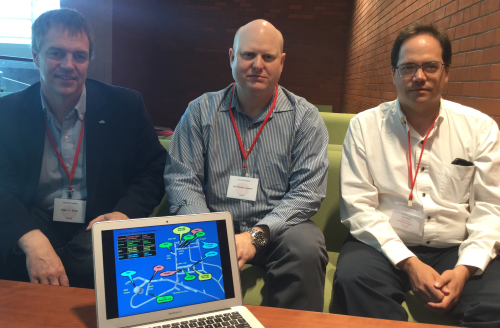
Squeaky clean: SNOLAB’s Nigel Smith (left), Ian Lawson (centre) and Chris Jillings.
By Hamish Johnston at the CAP Congress in Edmonton, Alberta
I’m a bit of a DIY enthusiast and one thing that I know about drilling into a masonry wall is that you should hold a vacuum-cleaner hose to the hole or you will end up with dust all over the wall and the floor below. Believe it or not, that is exactly what workers at SNOLAB in Canada do in order to keep background levels of radiation from affecting their dark-matter and neutrino detectors.
Today, I learned that concrete dust contains a few parts per million of uranium and thorium, which is slightly higher than the “mine dust” that is found 2 km below the Earth’s surface where SNOLAB is located. That might not sound like much, but it is important to the physicists working there, who are trying to push the radioactive backgrounds in their instruments to as low as one part per trillion. Indeed, anyone entering the lab from the neighbouring mine must shower first to get that pesky mine dust out of their hair.
The reason for this obsession with radioactive dust is that SNOLAB’s experiments try to spot the extremely rare signals that are produced when neutrinos interact with the matter in a detector – or could be produced if dark matter interacts with matter in a detector.
This and much more was explained by SNOLAB’s Nigel Smith, Ian Lawson and Chris Jillings, who gave three talks about the underground facility here at the Canadian Association of Physicists Congress. I had a coffee with the trio after the session and they gave me some insights into life underground. Indeed, coffee is not allowed outside of the lab’s dining area because it produces much more radiation than the aforementioned dust.
The lab is currently home to eight physics experiments, including the SNO+ detector, which will be up and running shortly. This is the replacement for the original Sudbury Neutrino Observatory (SNO), which provided the first clear evidence for neutrino oscillation. Unlike SNO, which used heavy water as the detection medium, SNO+ will use 800 tonnes of an organic liquid. It will also be used to search for “neutrinoless double beta decay” by loading the organic liquid with several tonnes of tellurium-130.
If neutrinoless double beta decay is observed, it would give us important information about the fundamental nature of neutrinos, as well as an absolute value for neutrino mass, which is an important goal in particle physicists.
Biologists are also taking advantage of the increased atmospheric pressure deep underground to study its effects on metabolism. Believe it or not, that experiment involves bringing fruit flies into SNOLAB’s pristine environment!
Guidelines
Show/hide formatting guidelines
this text was deletedwhere people live in harmony with nature and animals</q>
Some text